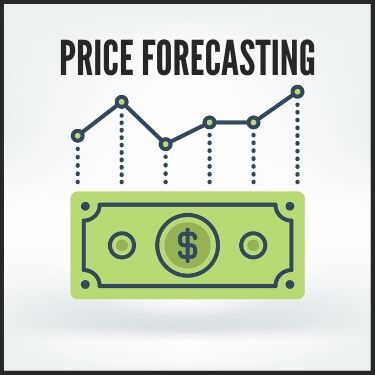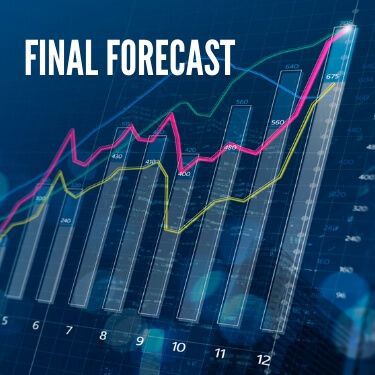
 Copy URL to Clipboard
Copy URL to Clipboard
Demand planning can seem like a huge endeavor, and since demand is always changing, the process has to be repeated several times a year to keep data current. Even with all the stress that comes with it, a good demand forecasting plan is vital to improving a business’s entire supply chain. Every business owner knows that one of the most frustrating parts about managing a business is trying to predict the market. Other aspects of businesses are concrete and can be planned out long before the business opens. Some traditions and practices even stick with a company for decades. But when it comes down to it, how can a business be expected to know what the public wants? How can they know how much of a product to produce, or how many materials to order?
What is demand planning? Demand planning is the process of estimating how much of a product will sell in the coming month. Doing this requires a complex, integrated business system, collaborating departments within the business, and accounting for both raw materials and finished products. Aspects like warehouse space and the company budget must be taken into consideration, as well as transportation, staff, and schedules.
The full answer is a lot more complicated than this, but understanding the fundamental purpose of demand planning is a start. Now, we can get into more of the specifics.
Table of Contents

Supply Chain Planning (SCP) is a complex process that includes effective demand planning as one of the vital steps. Each step is unique, and all of them must be followed in order to achieve the desired effects of a completely balanced supply and demand, streamlined business processes, and fast fulfillment. With that being said, there is no perfect model for how the steps should be achieved. This is because every business is different, and each has unique goals, supply chain management styles, and inventory.
The SCP process must be used to consider every single product offered by the company, since the demand is different for each product. Consider, for example, a company that sells smartphones. Every two years, they release a new model of their smartphone. The company still continues to sell the old version along with the new one, but at a discounted price. The old version will not be in as high of a demand as the new version, since more people would be interested in buying a new phone. Each of these smartphone products would need to be calculated separately, to avoid overstocking the warehouse with an excess of old phones that won’t sell. Forecast accuracy is important for making the most educated business decisions.
Now, with all the data collection going on, it is important to consider boundaries. Companies should carefully consider the privacy of their customers, and never collect information that could be potentially harmful. Companies should also craft a personal privacy policy, that outlines exactly what information they collect to any applicable parties. This not only ensures lawful and ethical behavior within the company, but it also helps the customers to trust them and their mission.
What is demand planning? Demand planning is the process of determining the potential future demand for an item in the future, based on sales data from the past. By looking at how demand has risen and fallen for the product over time, a trend or pattern could emerge. If a product fluctuates dramatically in a short period of time, known as the “intermittent demand,” then the company needs to know why. Sometimes, a company will try to compensate for the changes in demand by simply hiring and laying off workers as needed, but this makes the problem progressively worse. There’s even a name for when that happens: the “bullwhip effect.”
Many things could influence the success of a particular product, but the seasons, competition, partnerships, and obsolescence are a few of the common reasons. For example, a man that owns an ice cream truck will find that demand for his product goes up in the summer, since more people want ice cream when it is hot out. That causes the demand to rise and fall dramatically, but in a predictable way that makes it easy to plan around. The use of different demand planning tools could help visualize data trends, and make it easier to plan for future changes.
Demand planning can also be used to estimate how successful a new product release will be. Remember that smartphone company from a previous example? Every time they release a new smartphone, they do so at a precisely strategic time. The company considers the competition, how their products compare, and what the demand for those competitor’s phones looks like.
The new smartphone gets released when the market for other phones starts to stall, but before the old model of the phone becomes obsolete. People recognize the new smartphone based on the success of the previous model, compare it to other options, and conclude that it is the best option. The time that a new product is released can have a huge impact on sales, and this can be predicted ahead of time with the help of analyzing historical data and demand patterns.

The next step of the SCP process is price forecasting. In order to be profitable, a product has to be able to sell at a rate that is higher than the cost to produce it. In order to be reasonable, however, that profit margin should be significant enough to merit investing time into. So, price forecasting is done to see if the product is even worth thinking about.
To get an idea of what the statistical forecast should look like, the first thing to look for is data or trends over the past few years. What does the price variation look like? It could flatline and not vary much at all, vary wildly, become less expensive, or become more expensive over time. Then, they must consider what could have caused the change in price, and how it relates to demand. If the price dropped, they have to consider if that is because of a drop in demand, or if raising the prices would lower demand.
These trends are also compared to previous years’ price forecasts, to check how accurate they were in the past. The goal is to find the most profitable point at which to set the price, and whether that is a practical option. The price has to be high enough to make a profit off each individual item sold, but low enough to maximize demand. Naturally, this is a complicated endeavor that takes a lot of consideration.
The next thing a company has to consider is whether or not its facilities can keep up with the projected demand. This is called supply planning, and it is extremely important for ensuring success. The company must consider whether they can provide enough of the product to keep up, both from a technical and a financial standpoint. In other words, can their supply match the forecasted demand?
Several factors must be taken into consideration for a supply plan to be accurate. First, the company must consider their budget for producing the item. Once they figure out this number, or range of numbers, then it must be compared to the forecasted demand. Ideally, the ability to produce the product should exceed the amount projected to sell, so there is money left over after production. If the budget is too low, the company could go over-budget, or they may not produce enough of the product to keep up with the demand. An “out of stock” message can be extremely frustrating for the customer, and could cost the company future sales too.
Next, they have to predict the amount of time and effort that is dedicated to creating the product, and whether production can keep up. This is an issue especially if the production is outsourced, and outside of the company’s ability to closely control it. When a third-party controls the assembly of the product, then business owners cannot simply hire more workers to fix the problem. If the factory cannot keep up with the demand, then that must also be factored into the supply chain plan.
Finally, the warehouse that will be storing the product needs to have the capacity to withstand the number of products coming in. If there is no way to make the product fit safely in a warehouse, then another solution must be found. Warehouse space is a difficult thing for many businesses to handle, but outsourcing to a large third-party logistics (3PL) warehouse can take some of the stress off of the business. Space will generally never be an issue with a 3PL warehouse, and many come with distribution center services, like fulfillment and tracking.

Sales and Operations Planning (S&OP) is the process of collaboration between departments to handle the details of balancing supply and demand. It is also used to incorporate all the collected forecasts and information into a more comprehensive, all-encompassing plan. This information is collected and used alongside advanced technology, to reduce the likelihood of human error in the calculations. Everything will need to work seamlessly as a single unit, including sales, marketing, technology, accounting, operations, and any other department that influences the way the products are managed, presented, or transported. The end goal is to get everything working together, and align the plan with the company’s long term business goals.
Often times, it can be difficult to get different departments to collaborate well. This is especially true if the business has many locations, or if the departments do not generally interact. This can be orchestrated through department managers for the most part, but some form of open communication should eventually be adopted to avoid misunderstandings.
So that’s it, isn’t it? The plan should be ready to implement, right? Well no, not yet. The problem with forecasting is that no matter how well thought out the plan is, something unexpected could still happen that would change all of the plans. To counteract this, a company may use the same data to come up with several different plans, to account for things that can’t be predicted. Sudden weather changes, unexpected involvement in the market, a recall on an old product, or any number of situations could change customer needs and opinions, and therefore the product demand.
Although not every single possible situation can be predicted and accounted for, the most likely issues are taken into consideration, along with many more general situations. Changes to warehouse availability and production can also cause serious deviations to the plan, so those must be monitored closely and factored into the decisions. This analysis gives the company a sense of ease, since they know in any number of situations, they have a plan B to fall back on if something goes wrong.

Once everything has been double and triple-checked for accuracy and feasibility, then a Final Forecast, or Consensus Forecast, must be drafted together. This final forecast must include all plans for all SKUs, since the plan has to be completely encompassing in order to be accurate. All of the forecasts are written up and reviewed, and then all the departments must agree upon the outlined plans. Only then can the plan be implemented, which will be used to determine the supply and production schedule for the next planning period. The plan is then shared with any important figures in the supply chain process, like manufacturers and warehouse managers, so everyone is kept informed on the expectations. This enforces the kind of good communication that makes demand planning really work.
Usually this process is repeated every month, every quarter, or twice a year, depending on the size and complexity of the company. The more frequently the data is examined, the more accurate consecutive plans will be.
Demand planning is a lot of work, so it is understandable that someone would want to consider the benefits of it, to see if it’s worth the extra time and effort. Over time, the process gets easier as it is implemented, but the benefits of a successful plan can be measured immediately. A good demand planning process can really improve time efficiency and profits, if done correctly. Not only that, but it can help optimize customer service functions, and build a good reputation for the business. However, that doesn’t even scratch the surface of all the benefits of demand planning. If you still need convincing, here’s a more in-depth breakdown of some of the ways demand planning is changing the way the industry works—for the better.
Using demand planning can lead to a reduction in costs everywhere. The cost of production will be down since fewer actual items are being produced, and there are no added costs for rushing through anything, since everything operates on a schedule. Businesses could save tons of money on shipping freight, since they would require fewer emergency air-freight shipments. They could instead utilize more cost-efficient methods of transportation, like ocean shipping, since they can plan for things to arrive far in advance. Also, since fewer products would need to be stored for a long period of time, warehousing costs would be cheaper too.
Companies can enjoy the benefits of a quick Cash Conversion Cycle (CCC), which is the number of days between when a company pays for inventory from their supplier, and when a customer pays the company for the products. By reducing these times, the entire sales process gets accelerated. Businesses can get their profits sooner, and therefore go through inventory faster to make more sales. On average, a good demand plan can reduce the CCC by 35%, which translates to a tremendous increase in revenue. Although demand planning software can be expensive, companies tend to see a Return on Investment (ROI) after about 18-24 months.
Businesses should always be looking for ways to reduce the cost of production. When a product costs less to produce, then there is more freedom to reduce prices. Customers could get a better deal, without damaging the company’s revenue. Everyone appreciates a good value, so a decrease in price could actually lead to more sales and more overall profit for the company.
Overflowing inventory levels always seem to be an issue, with costs mounting for each new pallet stored. When items become obsolete and stop flying off the shelves like they used to, they tend to pile up in the warehouse. With all these overstocked products clogging up the shelves, more of the budget has to go towards making space for new products that will actually sell. By implementing a plan for dealing with changes in demand, a company can reduce the number of unsold products on the shelves, and optimize their warehouse space. Some companies have managed to reduce their inventory to an average of 15% less than their competitors, without damaging their ability to fulfill orders.
Let’s bring that smartphone example back for a moment. After the company releases the new and improved version of their popular smartphone, suddenly the old one is in much lower demand since everyone wants the newer, better phone. If the company continues to order as many of the old phones as they did in past years, then they would waste their money and warehouse space. The influence of the newly released smartphone should be taken into consideration when coming to a new demand planning decision, since it would greatly reduce the demand for the old version.
Demand planning has a number of excellent benefits, but the space efficiency it provides in warehouses allows for a lot more freedom in scaling the business, minimizing losses, and providing better services to customers. It gives business owners a better idea of what their inventory looks like, so they can make educated decisions on how to restock and manage their products.
By optimizing the warehouse space and controlling the flow of products into storage, companies can better orchestrate warehouse processes to deal with incoming products. A visible demand modeling report can allow warehouse staff to anticipate the volume of stock before it arrives, to prepare for it in advance. That way, the incoming stock gets processed as efficiently as possible.
3PL warehouses utilize something called a Warehouse Management System (WMS) to help with this as well. A WMS is a software program that can work alongside a complete supply chain plan to optimize warehouse operations. It compiles all the different sources of information in one easily viewable, fully integrated system. This allows for better organization and inventory management, which makes it easy to find any product located in the warehouse in seconds. Sometimes, a WMS will even assist with redesigning the floor plan or the shelf layout of the warehouse, to get the most possible usable space. By providing a visual representation of the layout of the stock, it can also give business owners a better idea of how to grow or diversify their business.

Running out of stock is a big deal for retail and eCommerce companies everywhere. Understock frequently harms businesses that haven’t prepared for changes in demand. Nothing is more frustrating to a customer than getting told that the product that they want is not available. Shipping times will have to adjust for when the product will be back in stock. Because of a lack of preparation on the company’s part, the products need to be produced and moved to the distribution center before they can be shipped to the customer. This process can add weeks to the customer lead time, and create dissatisfaction. Customers will not wait for the product to come back in stock—they will find a different place to buy it.
By using demand planning, companies can predict when demand will rise or fall, and they can adjust their supply accordingly. This means that there is never a point where a product runs out of stock, and a customer is never forced to wait extra time to have their order delivered. Companies with good demand plans can anticipate only 10% of the understock problems faced by other companies! Products are shipped out as soon as an order comes in, saving a tremendous amount of time. This ensures that customers do not move on to purchase from the competition, because they will always receive their packages in a timely manner.
A complete schedule for manufacturing and stocking products opens the doors for more opportunities to streamline processes even further. A warehouse can only hold so much, but a reliable demand plan can allow for products to be shipped out to a warehouse as the stock depletes, restocking everything exactly as it is needed, without even a prompt. This is known as Just in Time (JIT) delivery, and it also works for manufacturing locations as well. Raw materials can arrive right as they are needed to be manufactured, and then immediately shipped to the warehouse to fulfill the outlined demand plan. As long as everything is accurate, this makes the warehouse seem larger than it is. Products never run out, yet warehouses never get overstocked beyond capacity.

A good demand planning process allows for near immediate fulfillment of a customer’s order. If the customer demand has been accurately predicted, then there will always be stock immediately available to fulfill a customer’s order. Even in spite of the lowered stock, companies with great demand plans can get a 17% or more improvement on perfect order fulfillment. This means that the company is able to get more packages delivered correctly, on time, and in good condition.
As soon as an order comes in, the items can be packed and shipped out on that same day, as long as it happens during business hours. This is how large companies like Amazon can offer guaranteed two-day delivery! Quick fulfillment dramatically reduces customer lead times, resulting in more satisfied customers without sacrificing precious warehouse space.
A common problem for many businesses is the occasional fluctuation in customer demand that gets out of control. This is what’s known as the bullwhip effect. A small, unpredicted change in demand, like a couple of orders coming in right as the demand was predicted to fall, can cause businesses to overreact. As the information moves up the supply chain, supply is adjusted at the last minute to account for potential changes.
Those changes are typically not an indication of a larger change in the forecasted demand curve. Suddenly, businesses would be forced to deal with all of the extra products during a time when demand is lower than the supply was adjusted for. This issue can also work in reverse. If demand doesn’t immediately pick up when it was expected to, businesses might choose to not produce as much as originally planned, and end up with a deficit.
Essentially, the bullwhip effect is a problem that is caused by the poor interpretation of data, or a lack of proper communication. It can also be a result of not committing fully to demand planning, or trying to cut corners with forecasting technology. The problem can end up costing a business a tremendous percentage of revenue, depending on the degree of the miscalculation.
The best way to prevent a situation like this is to rely on the forecasted demand plan. Using advanced technology and open communication, an accurate demand plan can be made, and it should be followed closely. If the accuracy of the plan can be trusted, then it should be followed.
Businesses should also consider having a small “buffer stock” to account for minor fluctuations or errors in forecasting calculations. The extra stock will take up a little more space in the warehouse, but it may save the day if the primary stock runs out. If more supply ends up being necessary, it should be brought to the attention of the managers that formed the plan originally, so they can make the best decision on what to do next. Usually, minor adjustments are easy to make as long as they are approached carefully.
Now that you know what is demand planning, you’re probably pretty excited about implementing it. If you’re still not sure where to start, give R+L Global Logistics a call at (866) 989-3082. Our experienced supply chain consultants can answer any questions you may have, and can offer professional advice no matter the direction of your business.
Whether you need someone to handle warehousing, retail inventory management, kitting and assembly, or reverse logistics, R+L Global Logistics has the infrastructure, network, and team to get the job done. Regardless of whether you are starting a new business, trying to expand an existing business, or looking to reach into the eCommerce market, our team can help every step of the way!
